Plants have been our allies in the culinary and medicinal realms for ages.
We have relied on their bitters and astringency to tempt our taste buds and heal our ails. The use of herbs for health and wellness has recently increased as people seek more natural and readily available alternatives to conventional medicines. Understanding the mental and physical benefits of herbal remedies has prompted many homesteaders to plant Medicinal Gardens to keep these valuable plants close at hand.
But don’t despair if a rabbit has chewed through your ashwagandha or your feverfew has failed to thrive. Numerous medicinal herbs grow wild, and there are bound to plenty that can be found right on your homestead. Mainly considered weeds or nuisance plants, you may be overlooking valuable healers.
Listed below are ten of the most commonly foraged (also called wildcrafted) medicinal herbs you may find in your backyard.
Broad-Leafed Plantain (Plantago major)
Plantain is a beneficial herb in the treatment of skin ailments; most useful on bug bites and bee stings; the crushed leaves can also be applied to stop bleeding from cuts and scrapes, much like yarrow, this is most useful on open wounds.
Plantains’ astringent properties and diuretic effects make it especially effective in treating cystitis. The leaves infused into a tea are helpful as an expectorant and for soothing the lung; a warm cup of plantain tea is an effective treatment for respiratory conditions such as bronchitis.
The plantain seeds can be used as a bulk laxative (unsoaked seeds can cause abdominal discomfort).
Other medicinal uses of plantain include:
- Treatment of varicose veins
- Soothe hemorrhoids
- Reduce fever
- Counteract poisoning
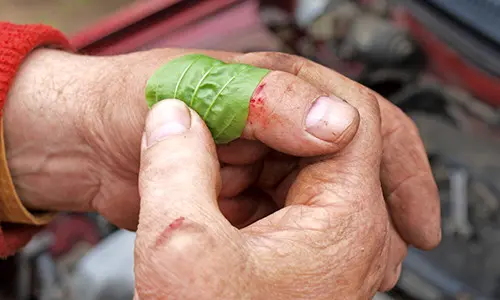
Burdock (Arctium lappa)
The deep roots of burdock, once considered the nemesis of homesteaders, are the keeper of potent detoxification benefits. Traditionally used to treat ailments such as gout, kidney stones, and fevers. All components of the plant can be used from root to seed.
Burdock has strong cleansing properties; for this reason, only small amounts should be used over a period of time, it is not suggested to use too much (either infusions or salves) too fast. Burdock is typically used to treat skin disorders, arthritic conditions, and abdominal complaints.
The root is especially helpful in relieving gastrointestinal problems. The root contains inulin, a soluble fiber that can help constipation, and mucilage, which acts as a barrier of protection on the lining of the stomach and intestinal tract.
Burdock’s antimicrobial and cleansing properties make it helpful in treating skin conditions such as eczema and psoriasis. Fevers caused by bacterial infections are also improved with the use of burdock.
Other medicinal uses of burdock include:
- Blood cleanser
- Anticoagulant
- Reduces blood-sugar
- Flushes impurities
⇒ Buy Here Your Own Seeds Before They Are All Gone. Only A Few Packs Available
Self-Heal (Prunella vulgaris)
Self-heal is truly a heal-all, and the small purple flower is likely the most overlooked of all wild herbs. Self-heal is a member of the mint family but tastes suspiciously like rosemary, likely because it contains the same potent antioxidant as rosemary, rosmarinic acid.
What is self-heal good for? Almost everything, but most notably, it is used for its anti-inflammatory properties in irritable bowel diseases such as Crohn’s and colitis. The small plant also packs a powerful anti-viral punch and has been used as a salve to heal cold sores and as
an infusion to improve cold and flu symptoms. The sky is the limit when it comes to self-heal.
Other medicinal uses of self-heal include:
- Lessening allergy symptoms
- Soothes sore throats
- Heals mouth ulcers
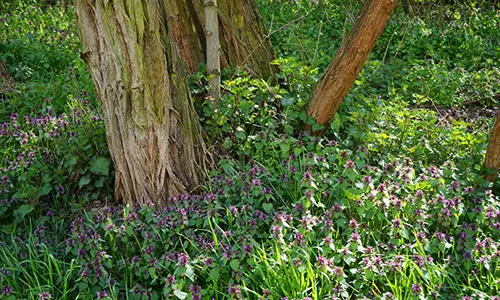
Dandelion (Taraxacum officinale)
Nothing says spring like the arrival of dandelions. The flowers make a sweet wine, and the seed pods are perfect for blowing wishes, but the common dandelion also has an impressive range of health benefits.
The leaves can be eaten fresh or dried and infused to create a diuretic effect, but unlike conventional diuretics, dandelion leaves are remarkably high in potassium, leaving the body’s mineral balance intact.
The roots have found popularity in mainstream society as a coffee substitute, with the roasted roots having a similar taste to everyone’s favorite hot beverage. A decoction of the root can help with constipation and is an overall aid to digestion.
Other medicinal uses of dandelion include:
- Promotes liver function
- Relieves eczema
- May help reduce cholesterol
- Clears up acne
Related: Just Like Doxycycline: The Antibiotic That Grows In Your Backyard

Comfrey (Symphytum officinale)
Otherwise known as knit bone, for its traditional use in mending broken bones, comfrey is a wonderful herb to have in your healing arsenal.
Comfrey makes a fantastic salve to heal an array of skin conditions; everything from poisonous parsnip to kitchen burns can benefit from an application of comfrey salve. The leaves crushed and applied as a compress to breaks and sprains can help reduce swelling and calm bruising.
As an anti-inflammatory, comfrey’s roots can be tinctured and applied to the skin to help with acne or other inflammatory conditions. Comfrey truly shines when used for wound healing as the allantoin found in the roots (and leaves) helps skin cells regrow. As you can see, comfrey is a very hardy perennial that has a vital role in the homesteader’s medicine cabinet.
Other medicinal uses for comfrey include:
- Digestive aid
- Pain relief
- Skin rejuvenator

Stinging Nettle (Urtica dioica)
Some people are unaffected by the sting of nettle, and others do their best to avoid it. No matter what camp you are in, everyone agrees that nettle has amazing healing properties.
A master anti-inflammatory nettle is mainly prepared as a tea and has been used to treat arthritic conditions such as gout. Nettle also holds promise in treating allergies, especially hay fever, reducing the symptoms of itching eyes and sneezing.
Stinging nettle is helpful in treating conditions of the male and female reproductive systems.
In men, a decoction of nettle root has been found to aid in the reduction of an enlarged prostate. In women, a tea made from the leaves and sipped on throughout the day helps with anemia due to heavy menstrual periods.
If you have nettle on your property, you likely know about it; if you get stung by the prickly leaves, you will not soon forget it. Take loving care of your nettle patch, and it will repay you for years.
Other medicinal uses of stinging nettle:
- Reduces tension
- Reduces hemorrhoids
- Soothes painful muscles
- Aids in elimination of kidney and gall stones
Related: Do You Have This Plant In Your Backyard?
Elder (Sambucus nigra)
Even those not in the know are aware of the medicinal qualities of elder. Found everywhere from your backyard to the local supercenter, elder is a sort of “gateway” herbal remedy, one that the general public has readily embraced during cold and flu season.
The elder’s flowers and berries are the beneficial parts of the plant; the leaves, roots, and bark are not to be used internally.
Infusing the flowers into a warm tea is a good practice for supporting the immune system, increasing perspiration, and flushing toxins when fighting a cold or flu. You can also make a tincture of the flowers for daily hay fever prevention.
Elderberries are so widely accepted as a healing herb that they can be found in several conventional cough and cold-fighting medications. You can create your own healing syrups at home by making a decoction of the berries and creating an elixir.
Other medicinal uses of elder include:
- Easing congestion
- Lower blood pressure
- Maintain blood sugar levels
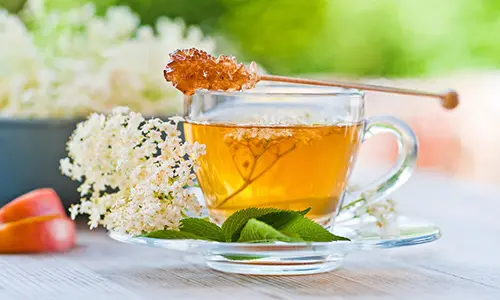
Red Clover (Trifolium pratense)
Walking along any country road or farm pasture, you are sure to find an abundance of red clover, a favorite livestock food; this purple-flowered weed also has many wellness benefits.
One of the red clovers’ most interesting benefits is the isoflavones the flower head contains. Isoflavones are a substance made by some plants that produce estrogen-like qualities—making red clover popular with women in perimenopause and facing a decline in estrogen production.
The flowers are the most commonly utilized part of the plant. Steeping fresh or dried flower heads in warm water creates a relaxing tea that can be used to soothe coughs in children or help lessen the symptoms of menopause. An Infused oil can be made from the flower heads to use on irritated skin or chapped lips. Generally considered a safe and edible herb, women who are pregnant or nursing should avoid using it due to its phytoestrogenic activity.
Other medicinal uses of red clover include:
- Protective of heart health
- Useful in treating skin conditions (eczema and psoriasis)
- Prevention of osteoporosis
- Soothing respiratory ailments
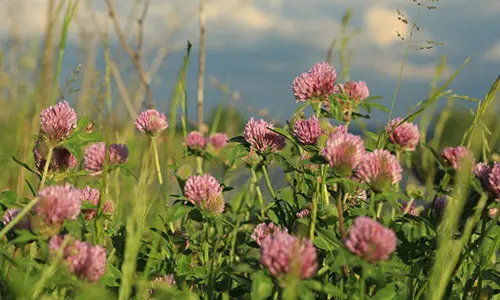
Chicory (Cichorium intybus)
Commonly found along roadsides with little blue daisy-shaped flowers, chicory is a favorite among herbalists and homesteaders; a plethora of medicinal uses and a fantastic coffee substitute make chicory a welcomed addition to your apothecary.
The roasted chicory roots make an excellent addition to coffee; the flavor it brings smoothes out coffee and balances the effects of caffeine. Chicory roots are also used as a stand-alone as a coffee replacement. Either way, the woody and nutty flavor of chicory root is reason enough to find it on your homestead.
Traditionally the root is the most common part of the chicory plant used, though the leaves are edible and quite tasty in a fresh salad.
Medicinally chicory is used to soothe and heal stomach and digestive tract disorders. A decoction of the root can aid in stimulating appetite and relieving constipation.
Other medicinal uses of chicory include:
- Treating gout
- Helps with gallbladder disorders
- Liver tonic
- Cleanses the urinary tract
Related: A Medicinal Garden Kit For Starting A Small Backyard Pharmacy
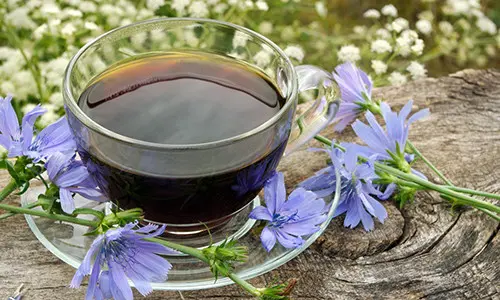
Mugwort (Artemisia vulgaris)
Known as the “mother of herbs,” mugwort has been used since the earliest recorded times. An herb that is multi-faceted and has long been associated with female reproductive health, mugwort is also effective around the homestead as a parasite preventative for livestock—making it an asset to any homesteader’s property.
Mugwort has been used traditionally to induce menstruation, help regulate the menstrual cycle and reduce pain associated with menstruation. For this reason, it is advised that pregnant women avoid mugwort.
Tinctures and teas can be made from the leaves and roots of the mugwort plant. Teas can be used as tonics to promote health, increase energy and reduce cramps. Mugwort has also been used as a sedative and is known to produce vivid dreams.
Other medicinal uses of mugwort include:
- Relieves constipation
- Stimulates gastric acid production
- Reduces anxiety and depression
- Helps with headaches
A quick stroll around your homestead will help provide you with the healing benefits of nature.
Use the plants and herbs available to you to experiment with teas and tinctures to restore balance and promote well-being.
You may also like:
 Trees In Your Backyard You Should Tap Right Now
Trees In Your Backyard You Should Tap Right Now
If You See This Plant in Your Backyard, Burn It Immediately! (Video)
This Is Why You Should Grow Quinoa
The Indispensable Medicinal Garden Every Homestead Should Have
If You Have This Plant in Your Backyard, You Will Never Run Out of Soap

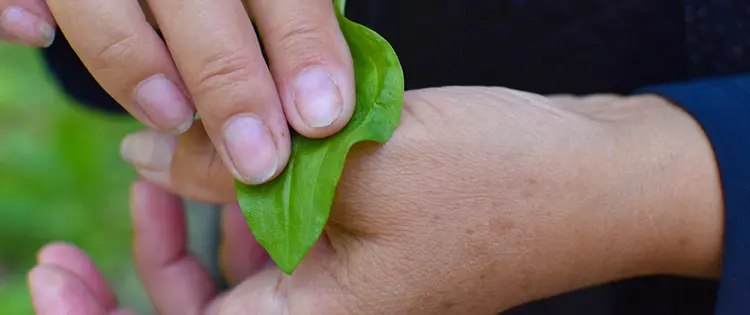








Please be aware that comfrey is no longer recommended for internal use because of its alkaloids. Please only use it externally. Do your own research and use at your own risk.
A wise warning to put in this article would be that ALL herbs must be properly identified before use. There are many poisonous look alikes. (ie: carrot, Queen Anne’s Lace, and hemlock all look very similar).
Please also study which parts of medicinal herbs are safe: leaves, seeds, roots, etc.